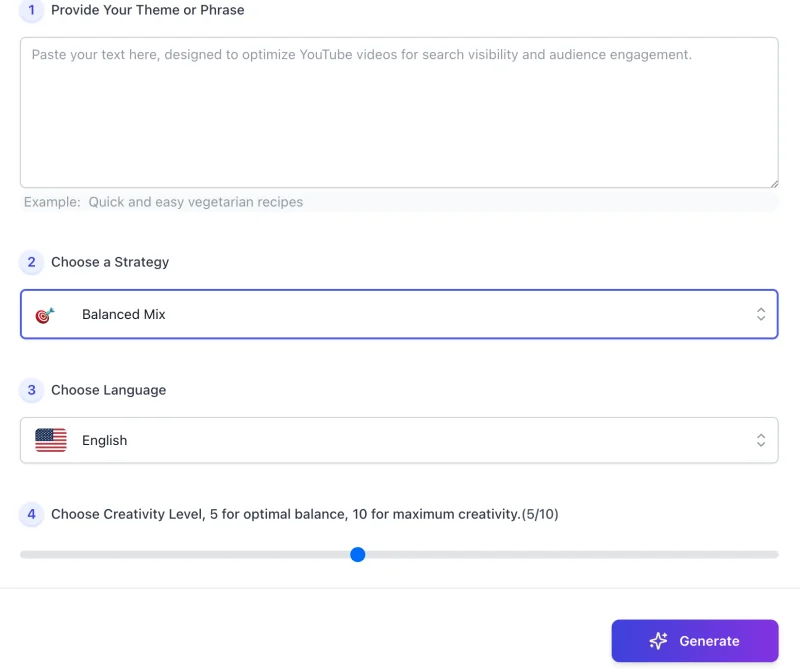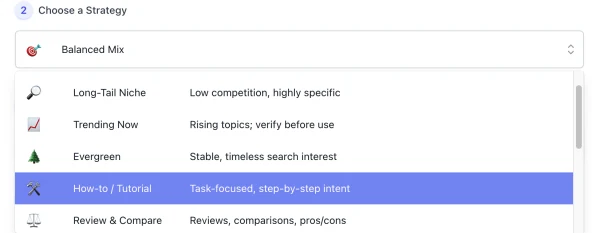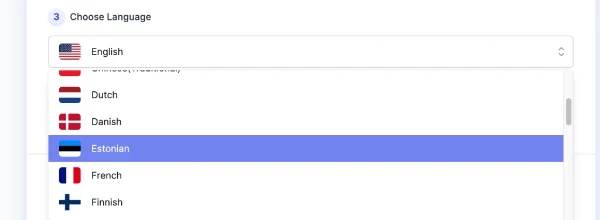This is the AIFreeBox AI YouTube Keyword Generator tool page—an online keyword strategy assistant for YouTube creators, brand marketing teams, and editors in education, review, and e-commerce channels. It helps map your video topic to search-aligned, long-tail phrases real viewers type, then suggests placement in Title, Video Description, and Tags.
On this page, you’ll find the tool’s capabilities and scope, who it’s for, a step-by-step workflow, and YouTube-specific tips, plus known issues with workarounds and FAQs.All focus to find actionable keywords suited to YouTube’s real queries.
What Can AIFreeBox AI YouTube Keyword Generator Do?
The AIFreeBox AI YouTube Keyword Generator is powered by transformer-based language models, fine-tuned to read a video topic the way viewers actually search. It’s not a “rank-fast” black box, but a YouTube-specific keyword strategy assistant.
Each run follows a clear path:
-
- Infer intent—tutorial, review, product, or local info.
- Apply a preset strategy—12 single-select options like Balanced Mix, Long-Tail Niche, or Shorts-First.
- Generate compact phrases—2–5 words, capped at 24, with duplicates merged and filler like best/top/ultimate removed.
- Attach guidance—each keyword shows where to use it (Title / Description / Tags) and why.
- The output is a structured set of ready-to-test phrases, not random words. If a term looks trend-driven, it’s flagged as a trend guess, never claimed as fact.
The design is human + AI: the AI drafts, you refine—cut generics, keep long-tail, add industry terms, then test in real titles and descriptions. Performance data—CTR, watch time, search queries—closes the loop. With 12 strategies and 33 languages, the tool adapts across goals and audiences. The tone stays practical and concise: keywords that flow straight into your YouTube workflow.
AIFreeBox YouTube Keyword Generator vs. Black-Box “Rank Fast” Tools
Quick, honest comparison — a strategy assistant built for YouTube vs. “rank-fast” black boxes.
| Dimension |
AIFreeBox AI YouTube Keyword Generator |
Black-Box “Rank Fast” Tools |
| 🎯 Purpose |
Intent-aligned keyword strategy assistant |
Quick-ranking promises without context |
| 🔍 Output |
2–5 word, deduplicated phrases (max 24) |
Long, generic keyword dumps |
| 📝 Guidance |
Each keyword includes placement + brief rationale |
No usage context; raw lists only |
| 🤝 Workflow |
Human + AI: AI drafts, you refine |
Fully automatic; little creator control |
| 🌍 Language & Strategy |
33 languages; 12 single-select strategy presets |
Often English-only; one-size-fits-all |
| 🛡️ Transparency |
Flags trend guess; no fabricated volumes |
Vague metrics; unverifiable claims |
| 📊 Integration |
Flows into Title / Description / Tags |
Detached from real YouTube workflow |
| ✅ Core Value |
Practical, usable, audience-aligned |
Over-promises, under-delivers |
Recommended Use Cases and Problem Areas
Scenarios where the tool is relevant, the issues it addresses, and who may benefit.
| Scenario |
Problem Addressed |
Potential Users |
| 🎥 Video Planning |
Difficult to align topics with actual viewer search terms |
YouTube creators, educators |
| 📝 Metadata Writing |
Uncertainty in filling titles, Channel descriptions, and tags effectively |
Channel editors, marketing teams |
| 📈 Niche Channel Growth |
General keywords too competitive; long-tail options underused |
Small creators, independent reviewers |
| 🌍 Multi-Language Publishing |
Need localized keywords across languages or regions |
Global brands, bilingual channels |
| ⏱️ Short-Form Content |
Hard to find concise, search-friendly terms for short videos |
Shorts creators, social media teams |
| 🛒 Product and Review Content |
Challenge in surfacing buyer intent or comparison keywords |
E-commerce, tech reviewers |
| 🎯 Tutorial and Educational Content |
Unclear how to phrase “how-to” searches into usable tags |
Teachers, training channels |
| 📊 Updating Older Videos |
Need to refresh keywords for underperforming or outdated content |
Existing channel owners |
| 🤝 Team Collaboration |
Difficulty keeping keyword use consistent across teams |
Agencies, multi-editor channels |
How to Find Keywords for Youtube with AIFreeBox AI:
Step-by-Step Guide

Step 1 — Provide Your Theme or Phrase
Enter a clear video topic (e.g., “quick vegetarian dinner ideas”). Specific inputs lead to more accurate, search-aligned keywords.
Step 2 — Choose a Strategy

Select one preset (Balanced Mix, Long-Tail, Review & Compare, Shorts-First, etc.). Each strategy frames phrasing and search intent differently.
Step 3 — Choose Language

Pick the output language to match your audience or target region.
Step 4 — Set Creativity Level
Use mid values (around 5/10) for balanced results, higher values for more variation.
Step 5 — Generate
Click Generate. The tool infers intent, applies the chosen strategy, and returns up to 24 compact, deduplicated phrases with suggested placement (Title / Description / Tags) and short rationales.
Step 6 — Review and Export
Copy or download results for use. Refine manually: drop generics, keep long-tail, add industry-specific terms.
Step 7 — Report Bug (A Real Human Support)

If something looks off, use Report Bug. A real support team reviews submissions quickly to keep the tool reliable.
Step 8 — Apply and Validate
Use the phrases in your video metadata, then validate with real metrics (CTR, watch time, search queries) and adjust as needed.
Summary: The AI provides structure and candidates; you refine with judgment and verify against audience data.
Choosing the Right Keywords: Tips
From marketing teams who tested this tool — how to pick the right words and where human judgment matters most.
- 🎯 Start clear, stay focused — input a specific topic (e.g., “budget travel vlogs Spain”) so keywords match real search queries.
- 🧩 Check intent, not just wording — ask: does this phrase reflect what viewers type when they want my video?
- ✂️ Trim the noise — remove overly generic terms (like “best” or “top”) and keep the ones with real context.
- 🔍 Keep the long-tail — phrases like “easy vegan pasta for beginners” get fewer searches but bring the right audience.
- 📝 Add your insider terms — industry-specific or brand-related words that AI won’t generate on its own.
- 📊 Test and rotate — use the AI list as a starting point, then swap out underperforming tags after checking CTR and watch time.
Summary: The AI suggests structured options, but the real lift comes from you — trimming generics, keeping long-tail, and adding context only you know. That mix is what helps a video gain the right exposure.
User Case Study
Example workflows that show how the tool and human judgment combine to create usable keywords for YouTube.
Case 1 — Small Travel Vlog Channel
Input: “budget travel vlogs Spain”
AI Draft Output:
budget travel spain vlog • cheap trips barcelona • spain travel tips • budget travel guide spain • spain vlog cheap hotels • spain food on budget
Human Refinement: Removed generic terms like “travel tips”, kept long-tail such as “cheap trips barcelona” and added industry-specific “backpacker hostels spain”.
Final Use:
– Title: “Backpacker’s Budget Travel Vlog — Spain on $30 a Day”
– Tags: “cheap trips barcelona, backpacker hostels spain, spain travel on budget”
– Description: “Tips for exploring Spain on a tight budget — food, hostels, and transport.”
Result: Keywords shifted from generic to niche-specific, aligning with the actual target audience of budget travelers.
Case 2 — Product Review Channel
Input: “wireless earbuds review 2025”
AI Draft Output:
wireless earbuds 2025 review • best bluetooth earbuds • noise cancelling wireless buds • earbuds under 100 • new wireless earbuds release
Human Refinement: Dropped vague phrases like “best bluetooth earbuds”, kept focused terms like “earbuds under 100” and added missing industry terms: “ANC earbuds 2025, battery life test earbuds”.
Final Use:
– Crafting a Hook Title : “Wireless Earbuds 2025 Review — Top Picks Under $100”
– Tags: “earbuds under 100, anc earbuds 2025, wireless earbuds battery test”
– Description: “Hands-on review of 2025’s new earbuds — ANC, battery life, and real-world testing.”
Result: Final keywords balanced audience search intent (affordable earbuds) with expert terminology (ANC, battery test) for stronger exposure.
Summary: These cases show the principle: the AI provides structured candidates; creators refine by trimming generic terms, keeping long-tail specifics, and adding domain context. That balance is what improves real exposure.
Keyword Strategy Presets
Choose one preset to guide how the tool generates keywords. Each preset focuses on a different type of search intent or content goal.
- ⚖️ Balanced Mix — a blend of broad and long-tail terms for general use.
- 🔍 Long-Tail Niche — focus on specific, less competitive phrases.
- 📈 Trending Now — highlight currently rising terms (marked as trend guess).
- 🆚 Review & Compare — phrases that frame comparisons or evaluations.
- 🌍 Localized — region or language-specific keyword suggestions.
- ⏱️ Shorts-First — compact terms designed for YouTube Shorts.
- 🛒 Purchase Intent — buyer-oriented phrases for product videos.
- 🧩 Semantic Expansion — related terms that broaden topic coverage.
- 📊 Competitor Gap — fill missing angles not usually covered by broad keywords.
- 🎯 Educational Focus — “how-to” and tutorial-friendly phrasing.
- 🎤 Event or Review Cycle — useful for seasonal, yearly, or product-cycle content.
- 💬 Conversational — natural, audience-like queries for informal videos.
Limitations & Common Issues
What to expect when using the tool, and how to handle typical challenges.
| Limitation / Issue |
Explanation |
Suggested Solution |
| 📉 No ranking guarantee |
Keywords are suggestions; actual exposure depends on content quality and engagement. |
Use as guidance only; monitor CTR and watch time to validate choices. |
| ⏳ Not real-time data |
“Trend guess” terms are based on model patterns, not live search analytics. |
Cross-check with YouTube Analytics or Google Trends for confirmation. |
| ✂️ Generic terms may appear |
Some broad keywords (e.g., “best”, “top”) can dilute relevance. |
Manually refine: remove generics, keep long-tail, add domain-specific terms. |
| 🌍 Limited context awareness |
May not fully capture cultural or regional nuances in certain languages. |
Adjust outputs by adding local terms or idioms your audience uses. |
| 👥 Audience behavior varies |
Even strong keywords may underperform if they don’t match viewer interests. |
Test different sets, iterate based on search queries and performance data. |
| 🔒 Brand or protected terms |
These only appear if you explicitly include them in your input. |
Add brand names manually when relevant and permissible. |
| 🛠️ Occasional errors |
Unexpected outputs or formatting issues may occur. |
Use the Report Bug button — a human support team will follow up promptly. |
FAQs
Can this tool guarantee my video will rank higher?
No. The tool suggests intent-aligned keywords, but rankings depend on many factors — video quality, audience retention, and competition. Use the outputs as a guide, not a guarantee.
Why are some keywords marked as “trend guess”?
These are model-based suggestions for potentially trending terms. They are not real-time analytics. Always cross-check with YouTube Analytics or Google Trends if trends are critical.
How many keywords should I actually use in one video?
Most creators find 10–15 focused keywords sufficient. Adding too many broad terms can dilute relevance. Choose the ones that fit your audience and content best.
What if the output feels too generic?
This can happen with broad inputs. Refine by removing generic terms, keeping long-tail phrases, and adding industry-specific language that only you know. AI drafts — you finalize.
Does it support different languages?
Yes, the tool supports 33 languages. However, cultural nuance and local phrasing may still need human adjustment for accuracy and naturalness.
Is it useful for small or new channels?
Yes. Long-tail and niche presets are especially helpful for small channels to target less competitive searches. Human judgment is key to picking terms that match your unique angle.
What happens if I find errors or irrelevant keywords?
You can use the Report Bug option. A support team reviews submissions directly, ensuring feedback is acted upon. This helps improve accuracy for future use.
Should I replace my own keyword research with this tool?
No. Think of it as a starting point. Combine its suggestions with your knowledge of the audience, industry terms, and analytics. Human context makes the results effective.
Creator’s Note
The AI YouTube Keyword Generator was never meant to be a shortcut to rankings.
Its role is to provide structure — surfacing candidate phrases, trimming noise, and pointing out placement options.
The judgment, the voice, and the context always remain with you.
In practice, this means the AI drafts and you decide: which terms to keep, which to cut, and which to enrich with your own industry knowledge.
This balance is what makes keywords meaningful — they are not just words, but signals that connect your content with the right audience.
I believe AI should act as a collaborator, not a replacement. By combining algorithmic suggestions with human intuition,
we give your content a better chance to be discovered in ways that feel authentic, measured, and sustainable.
That’s the philosophy behind this tool, and why I see it as a partner in the creative process — never the driver.
— Matt Liu
2025-10-16
🎯 Try it out now — free, online, and ready when you are.
Boost your video visibility — let AI suggest SEO-friendly, trending, and relevant YouTube keywords that help your content reach the right audience and grow faster.



